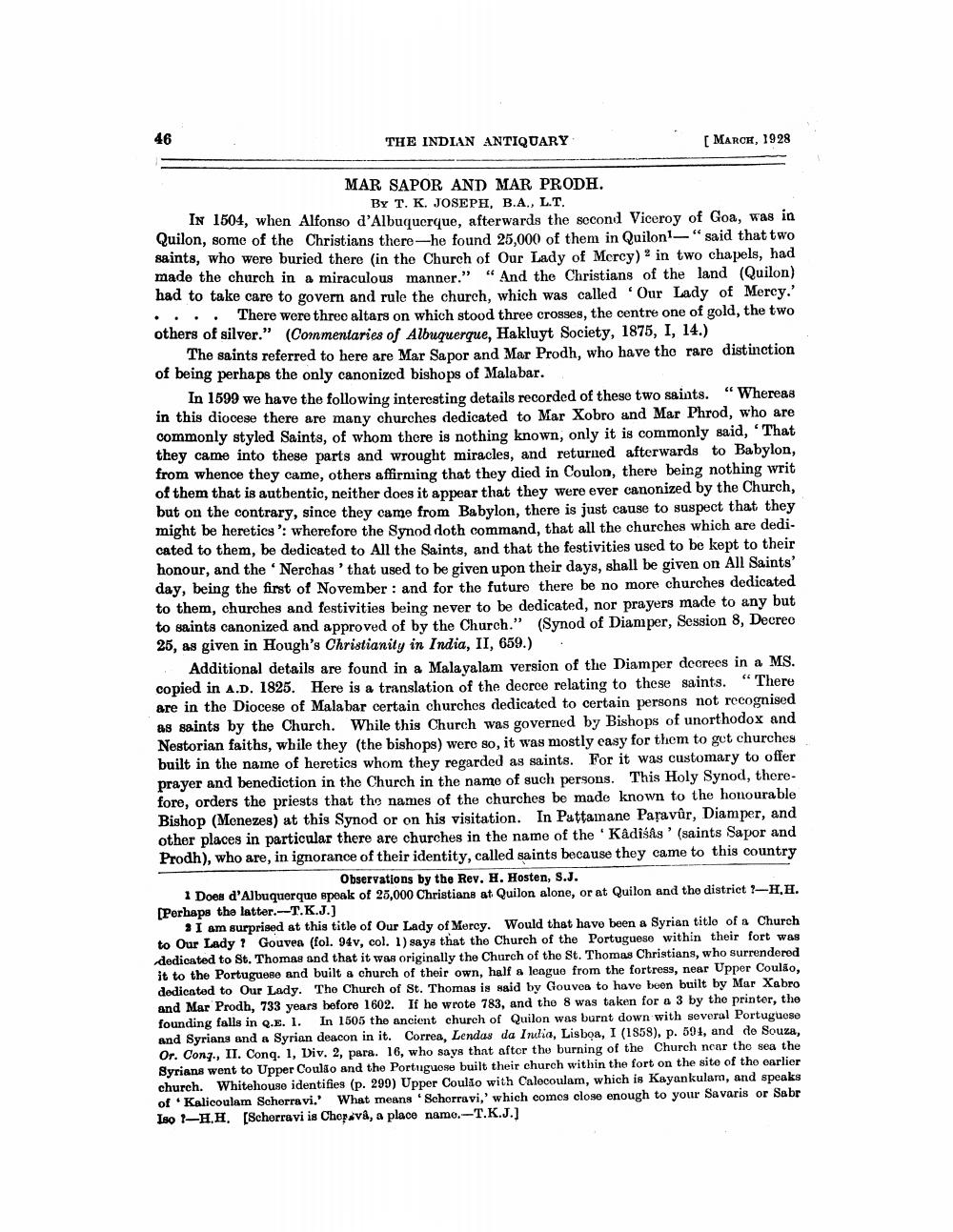________________
THE INDIAN ANTIQUARY
[ MARCE, 1928
MAR SAPOR AND MAR PRODH.
BY T. K. JOSEPH, B.A., LT, IN 1504, when Alfonso d'Albuquerque, afterwards the second Viceroy of Goa, was in Quilon, some of the Christians there-he found 25,000 of them in Quilon-"said that two saints, who were buried there in the Church of Our Lady of Mercy) in two chapels, had made the church in a miraculous manner." " And the Christians of the land (Quilon) had to take care to govern and rule the church, which was called 'Our Lady of Mercy.' .... There were three altars on which stood three crosses, the centre one of gold, the two others of silver." (Commentaries of Albuquerque, Hakluyt Society, 1875, I, 14.)
The saints referred to here are Mar Sapor and Mar Prodh, who have the rare distinction of being perhaps the only canonized bishops of Malabar.
In 1599 we have the following interesting details recorded of these two saints. “Whereas in this diocese there are many churches dedicated to Mar Xobro and Mar Phrod, who are commonly styled Saints, of whom there is nothing known, only it is commonly said, 'That they came into these parts and wrought miracles, and returned afterwards to Babylon, from whence they came, others affirming that they died in Coulon, there being nothing writ of them that is authentic, neither does it appear that they were ever canonized by the Church, but on the contrary, since they came from Babylon, there is just cause to suspect that they might be heretics': wherefore the Synod doth command, that all the churches which are dedicated to them, be dedicated to All the Saints, and that the festivities used to be kept to their honour, and the Nerchas 'that used to be given upon their days, shall be given on All Saints' day, being the first of November : and for the future there be no more churches dedicated to them, churches and festivities being never to be dedicated, nor prayers made to any but to saints canonized and approved of by the Church." (Synod of Diamper, Session 8, Decreo 25, as given in Hough's Christianity in India, II, 659.)
Additional details are found in a Malayalam version of the Diamper decrees in a MS. copied in A.D. 1825. Here is a translation of the decree relating to these saints. “There are in the Diocese of Malabar certain churches dedicated to certain persons not recognised as saints by the Church. While this Church was governed by Bishops of unorthodox and Nestorian faiths, while they (the bishops) were so, it was mostly easy for them to get churches built in the name of heretics whom they regarded as saints. For it was customary to offer prayer and benediction in the Church in the name of such persons. This Holy Synod, therefore, orders the priests that the names of the churches be made known to the honourable Bishop (Menezes) at this Synod or on his visitation. In Pattamane Paravûr, Diamper, and other places in particular there are churches in the name of the 'Kâdiśás ' (saints Sapor and Prodh), who are, in ignorance of their identity, called saints because they came to this country
Observations by the Rev. H. Hosten, S.J. 1 Does d'Albuquerque speak of 25,000 Christians at Quilon alone, or at Quilon and the district ?-H.H. [Perhaps the latter.--T.K.J.)
3 I am surprised at this title of Our Lady of Mercy. Would that have been a Syrian title of a Church to Our Lady ? Gouvea (fol. 94v, col. 1) says that the Church of the Portuguese within their fort was dedicated to St. Thomas and that it was originally the Church of the St. Thomas Christians, who surrendered it to the Portuguese and built a church of their own, half a league from the fortress, near Upper Coulão, dedicated to Our Lady. The Church of St. Thomas is said by Gouvea to have been built by Mar Xabro and Mar Prodh, 733 years before 1602. If he wrote 783, and the 8 was taken for a 3 by the printer, the founding falls in Q.E. I. In 1505 the ancient church of Quilon was burnt down with several Portuguese and Syrians and a Syrian deacon in it. Correa, Lendas da India, Lisboa, I (1858), p. 591, and de Souza, Or. Con ., II. Conq. 1, Div. 2, para. 16, who says that after the burning of the Church near the sea the Syrians went to Upper Coulio and the Portuguese built their church within the fort on the site of the earlier church. Whitehouse identifies (p. 290) Upper Coulio with Caloooulam, which is Kayankulam, and speaks of Kalicoulam Schorravi.' What means 'Schorravi,' which comes close enough to your Savaris or Sabr Iso 1-H.H. (Scherravi is Chepxvå, a place namo.-T.K.J.)




